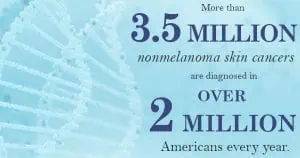
While dermatologists are known for prescribing acne treatment products and treating cosmetic concerns, many patients make an appointment at their local dermatologist clinics for more serious reasons. With one in five Americans developing skin cancer over the course of their lives, it is extremely important you take steps to protect your skin from harmful UV rays and detect any worrying signs as early as possible. But how should you prepare for an appointment with dermatology and skin cancer specialists? How should you proceed at the exam itself? To make skin examinations as effective as possible, dermatology and skin cancer specialists recommend following a few simple steps to increase your doctor’s ability to notice potential symptoms. Read on to learn how you can make the most of your next appointment.
Before the Appointment
While it is important to schedule regular skin examinations with a dermatologist, including full skin maps for people with a high risk of melanoma, it is also important to perform frequent self-exams. If you notice any worrying signs during these self-checks, including bleeding, changing or new growths, make a note of the location and contact your dermatologist. But whether you’re going in to have a specific area checked or just a regular examination, take a moment to remove nail polish from your fingernails and toenails before you leave: skin cancer can form in the nail bed, and your dermatologist will want to check this area.
At the Appointment
The length of your appointment will likely depend on the number of moles you have: if you have never had an atypical mole, the exam could take as little as 10 minutes. However, the more moles you have, the longer the appointment will take, as a high number of these marks signifies a higher risk of melanoma, the most aggressive form of skin cancer. While melanoma is highly curable when it is detected early, advanced melanoma can fatally spread to the lymph nodes and internal organs, making self-exams and appointments with dermatology and skin cancer specialists extremely important. If you don’t know how to conduct a self-exam or have other questions, ask your doctor during the appointment. Additionally, don’t forget to direct their attention to any worrying changes you may have noticed. Your doctor will usually order a biopsy if there is anything to be concerned about.
In Between Exams
More than three and a half million nonmelanoma skin cancers are diagnosed in over two million Americans every year. For this reason, it is important to take steps to reduce your risk of joining the crowd: make sure you wear sunscreen and eye protection year-round, avoid tanning and sunburn, and pay attention to local weather conditions and skin cancer risk factors. This is especially true when it comes to identifying cancerous moles: dermatology and skin cancer specialists often report that patients are worried about itchy moles or raised moles. However, while itching can be a sign of skin cancer, it is important to check that the mark is not simply irritated by clothing. Likewise, raised moles should be checked regularly, but are no more inherently dangerous than other marks on your skin.
Do you have questions about your skin cancer risk or need help checking for signs of this common condition? Contact dermatology and skin cancer specialists in your area for assistance.





